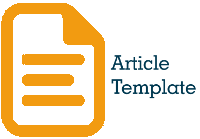DESIGNING USER INTERFACE AND USER EXPERIENCE OF MOBILE-BASED NGURILING KOTA TASIK (NGULISIK) BUS E-TICKET APPLICATION WITH DESIGN THINKING METHOD
DOI:
https://doi.org/10.35457/antivirus.v17i1.3047Keywords:
User Interface, User Experience, E-Ticket, Ngulisik, Metode Design ThinkingAbstract
Ngulisik adalah bus wisata di kabupaten tasikmalaya. Bus wisata ngulisik sendiri sudah mengatur tiketnya secara manual. Semakin pesatnya kemajuan teknologi informasi dan inovasi yang diadopsi dalam smartphone semakin memudahkan segala aktivitas manusia, seperti aplikasi e-ticket yang memudahkan masyarakat untuk memesan tiket hati. Perancangan aplikasi dimulai dengan desain desain antarmuka yang merupakan langkah awal implementasi ide, alur, dan cara kerja aplikasi yang dirancang pada akhirnya. Metode yang digunakan adalah design thinking. Metode design thinking terdiri dari emphatize, define, ideate, prototype dan test.Hasil uji desainer dengan 10 peserta menggunakan pertanyaan kemudahan tunggal untuk menguji kemudahan pengguna dengan hasil rank persentil tugas sebesar 89%, dan seq raw score sebesar 6.
Downloads
References
[2] I. M. Safira and A. Rakhman, “Rancang Bangun Aplikasi E-Ticketing Travel Antar Kota Berbasis Android Dengan Menggunakan Metode Waterfall,” Pros. SENIATI, vol. 5, pp. 141–147, 2019, [Online]. Available: http://ejournal.itn.ac.id/index.php/seniati/article/download/2509/1567
[3] C. R. Management, “Perancangan fitur,” vol. 9, no. September, pp. 259–266, 2014.
[4] V. Y. M. Suratno, “Kajian Tingkat Efektivitas Penggunaan E-Ticketing Oleh Penumpang Batik Solo Trans Di Surakarta Dan Sekitarnya,” J. Bumi Indones., vol. 2, no. 3, pp. 287–296, 2019.
[5] R. A. Murdiono, H. Tolle, and A. P. Kharisma, “Evaluasi User Experience Pada Aplikasi Mobile Penjualan Tiket Online,” J. Pengemb. Teknol. Inf. dan Ilmu Komput., vol. 2, no. 5, pp. 2078–2085, 2018, [Online]. Available: http://j-ptiik.ub.ac.id
[6] S. F. Widyono, N. Hendrakusma, and M. A. Akbar, “Perancangan User Interface Aplikasi Travelingyuk Berbasis Mobile Menggunakan Metode Human Centered Design (HCD),” J. Pengemb. Teknol. Inf. dan Ilmu Komput., vol. 3, no. 8, pp. 7415–7424, 2019, [Online]. Available: http://j-ptiik.ub.ac.id/index.php/j-ptiik/article/view/6022
[7] B. Suteja, U. K. Maranatha, A. Harjoko, and U. G. Mada, “Perancangan User Interface E-Learning Berbasis Web Perancangan User Interface E-Learning Berbasis Web,” vol. 2008, no. March, pp. 36–46, 2015.
[8] T. Schlatter and D. Levinson, Visual usability: Principles and practices for designing digital applications. 2013.
[9] E. Susanti, E. Fatkhiyah, and E. Efendi, “Pengembangan Ui/Ux Pada Aplikasi M-Voting Menggunakan Metode Design Thinking,” Pros. Simp. Nas. Rekayasa Apl. Peranc. dan Ind. , vol. 18, no. 1, pp. 364–370, 2019, [Online]. Available: http://hdl.handle.net/11617/11706
[10] J. Brooke, “SUS: a retrospective, Journal of Usability Studies,” J. Usability Stud., vol. 8, no. 2, pp. 29–40, 2013.
[11] M. Afwan, S. Sumardi, and R. Septiana, “Perancangan Aplikasi Pemantauan Rumah Kaca Pintar Berbasis Android,” J. Tek. Komput., vol. 1, no. 1, pp. 21–29, 2022, doi: 10.14710/jtk.v1i1.34573.
[12] Veni Manik, C. Hetty Primasari, Yohanes Priadi Wibisono, and Aloysius Bagas Pradipta Irianto, “Evaluasi Usability pada Aplikasi Mobile ACC.ONE menggunakan System Usability Scale (SUS) dan Usability Testing,” J. Sains dan Inform., vol. 7, no. 1, pp. 1–10, 2021, doi: 10.34128/jsi.v7i1.286.
Downloads
Published
Issue
Section
License
Authors who publish with this journal agree to the following terms:
- Copyright on any article is retained by the author(s).
- Author grant the journal, right of first publication with the work simultaneously licensed under a Creative Commons Attribution License that allows others to share the work with an acknowledgement of the work’s authorship and initial publication in this journal.
- Authors are able to enter into separate, additional contractual arrangements for the non-exclusive distribution of the journal’s published version of the work (e.g., post it to an institutional repository or publish it in a book), with an acknowledgement of its initial publication in this journal.
- Authors are permitted and encouraged to post their work online (e.g., in institutional repositories or on their website) prior to and during the submission process, as it can lead to productive exchanges, as well as earlier and greater citation of published work.
- The article and any associated published material is distributed under the Creative Commons Attribution-ShareAlike 4.0 International License











